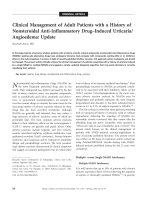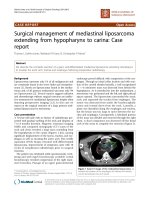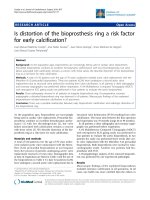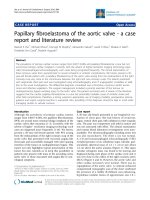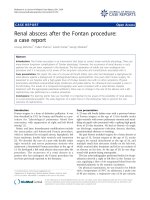Báo cáo y học: " Penetrating injury of the hand with a door handle: a case report" ppt
Bạn đang xem bản rút gọn của tài liệu. Xem và tải ngay bản đầy đủ của tài liệu tại đây (312.51 KB, 3 trang )
BioMed Central
Page 1 of 3
(page number not for citation purposes)
Journal of Medical Case Reports
Open Access
Case report
Penetrating injury of the hand with a door handle: a case report
Kiran Singisetti*, Michail Kokkinakis and Nanjappa Shankar
Address: Department of Trauma and Orthopaedics, Queen Elizabeth Hospital, Gateshead, NE9 6SX, UK
Email: Kiran Singisetti* - ; Michail Kokkinakis - ;
Nanjappa Shankar -
* Corresponding author
Abstract
Introduction: Penetrating injuries of the hand with various sharp objects have previously been
reported. In this report we describe an unusual penetrating injury of the hand caused by a door
handle.
Case presentation: A 32-year-old woman presented with a door handle stuck into her hand.
After a preliminary assessment she was immediately taken to theatre. Broad spectrum antibiotics
were administered along with tetanus toxoid. Soft tissue, including neurovascular integrity, was
assessed and confirmed during the operation. She had a good functional recovery at follow-up.
Conclusion: A door handle can occasionally cause a penetrating injury of the hand which should
be treated with early intervention, including a careful assessment of soft tissue and neurovascular
integrity.
Introduction
Doors and door related injuries have been reported in the
literature but most often they are related to crushing of the
fingers, particularly the tips. Minor injuries often involve
bruising or a blackened fingernail when a hand is caught
in the latch end of the door as someone carelessly closes
it. Sometimes the injury is more serious such as degloving
injuries or fractures [1]. Injuries related to door handles
have been very infrequently reported. Pointed door han-
dles have been reported to pose a significant risk of ocular
and peri-ocular injuries among young children [2,3]. We
report an unusual injury where a door handle was found
completely embedded into the hand of a woman.
Case presentation
A 32-year-old woman presented with a door handle stuck
into her left non-dominant hand. While trying to move an
old door at home, it accidentally fell on her injuring the
left hand. The handle had passed through the dorsal
aspect of the first web space and had exited though the
volar aspect of the hand. She was able to move her fingers
and had no distal neurovascular deficit at presentation.
The capillary refill time was less then 2 seconds and the
fingers showed no discoloration. There was minimal
bleeding from the wound and there were no other associ-
ated injuries. After a preliminary assessment she was
immediately taken to theatre. Clinical photographs (Fig-
ure 1) and radiographs (Figure 2 and 3) were taken preop-
eratively. Tetanus toxoid and intravenous antibiotics were
administered. A tourniquet was used at appropriate pres-
sure to aid the procedure. Intraoperative findings showed
some 'paint' debris in the deeper tissues and the wound
was washed with normal saline. The wound involved the
capsule of the first metacarpophalangeal joint, which was
repaired with 4-0 vicryl sutures. The integrity of tendons,
nerves and blood vessels was confirmed and appropriate
Published: 8 December 2008
Journal of Medical Case Reports 2008, 2:377 doi:10.1186/1752-1947-2-377
Received: 27 January 2008
Accepted: 8 December 2008
This article is available from: />© 2008 Singisetti et al; licensee BioMed Central Ltd.
This is an Open Access article distributed under the terms of the Creative Commons Attribution License ( />),
which permits unrestricted use, distribution, and reproduction in any medium, provided the original work is properly cited.
Journal of Medical Case Reports 2008, 2:377 />Page 2 of 3
(page number not for citation purposes)
debridement and washout was performed. The wound
was then reviewed after 48 hours and a delayed primary
closure performed. The patient had regained good hand
function and the wound healed unremarkably at follow-
up.
Discussion
Penetrating injuries of the hand are generally encountered
in cases of gunshot and stab injuries. To our knowledge, a
penetrating injury by a door handle has not previously
been described in the literature. A debridement procedure
and antibiotic cover are generally the essence of primary
management. The use of broad spectrum antibiotics such
as third generation cephalosporins is preferred but this
may need to be modified depending on individual situa-
tions [4]. If surgical removal of a foreign body or surgical
exploration of a puncture wound is decided upon, it must
be performed under adequate anaesthesia and tourniquet
control [5]. Attention to the integrity of the neurovascular
and musculotendinous structures is important to improve
the final outcome. Early mobilisation and physiotherapy
helps in the return of functional activities after such inju-
ries [6].
Conclusion
Objects such as door handles can occasionally cause pen-
etrating injuries of the hand. Such injuries should be man-
aged with meticulous early surgical exploration and care
to check neurovascular integrity.
Consent
Written informed consent was obtained from the patient
for publication of this case report and accompanying
images. A copy of the written consent is available for
review by the Editor-in-Chief of this journal.
Competing interests
The authors declare that they have no competing interests.
Authors' contributions
KS was involved with the initial writing of the manuscript
including the literature search. MK was involved with the
initial management of the patient and reviewed the man-
uscript. NS was the senior author responsible for the man-
agement of the patient.
References
1. Sinha M: An unusual foreign body in the hand. J Hand Surg Eur
Vol 2007, 32(2):231-232.
2. Chaudhry IA, Al-Sharif AM, Shamsi FA, Elzaridi E, Al-Rashed W:
Severe ocular injuries from pointed door handles. Ophthalmol-
ogy 2005, 112(10):1834-1837.
Clinical photograph of handFigure 1
Clinical photograph of hand.
Antero-posterior radiograph of handFigure 2
Antero-posterior radiograph of hand.
Lateral radiograph of handFigure 3
Lateral radiograph of hand.
Publish with BioMed Central and every
scientist can read your work free of charge
"BioMed Central will be the most significant development for
disseminating the results of biomedical research in our lifetime."
Sir Paul Nurse, Cancer Research UK
Your research papers will be:
available free of charge to the entire biomedical community
peer reviewed and published immediately upon acceptance
cited in PubMed and archived on PubMed Central
yours — you keep the copyright
Submit your manuscript here:
/>BioMedcentral
Journal of Medical Case Reports 2008, 2:377 />Page 3 of 3
(page number not for citation purposes)
3. Kozielec GF, To K: Penetrating eye injury from a metal wedge.
Ophthalmic Surg Lasers 1999, 30(1):59-60.
4. Mirzayan R, Schnall SB, Chon JH, Holtom PD, Patzakis MJ, Stevanovic
MV: Culture results and amputation rates in high-pressure
paint gun injuries of the hand. Orthopedics 2001, 24(6):587-589.
5. Stein F: Foreign body injuries of the hand. Emerg Med Clin North
Am 1985, 3(2):383-390.
6. Lerner A, Stein H, Stolero J, Volpin G: Unusual penetrating hand
injuries due to underwater fishing harpoons. Orthopedics 2001,
24(4):385-387.
